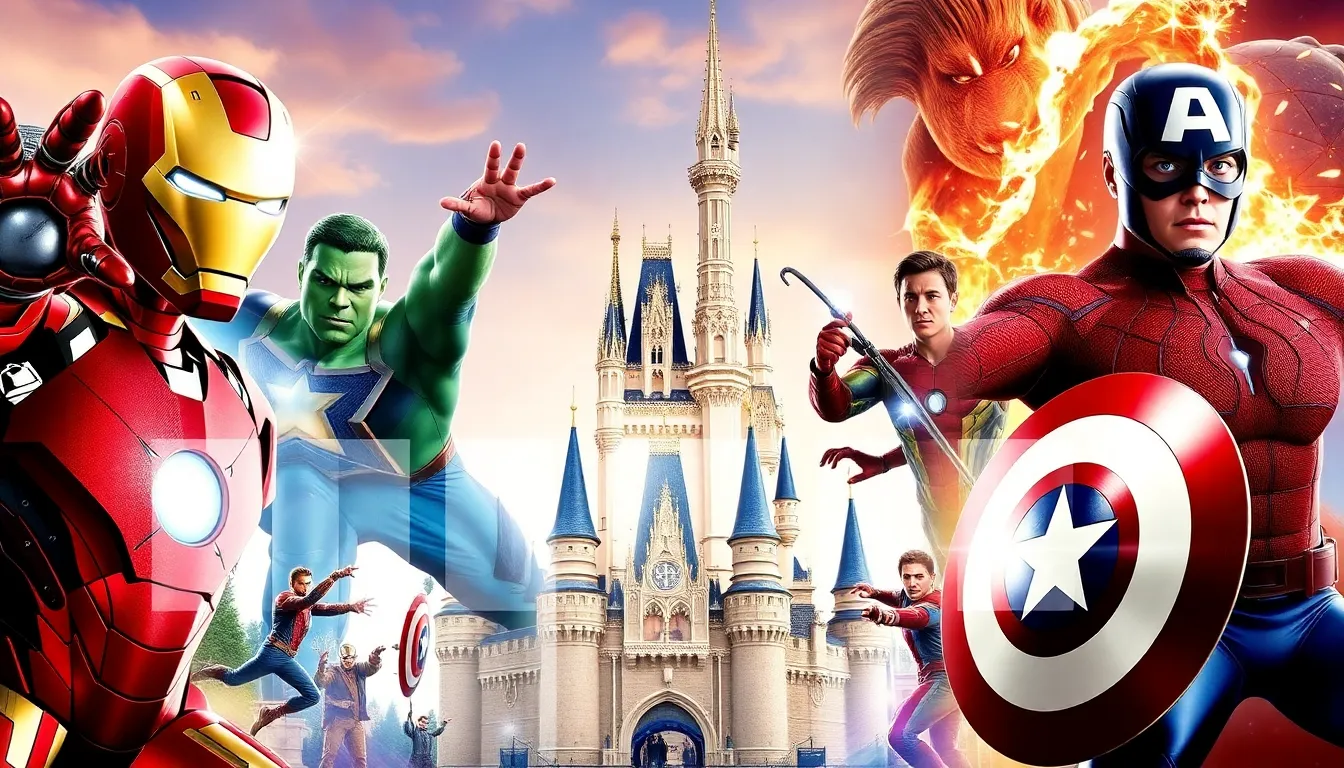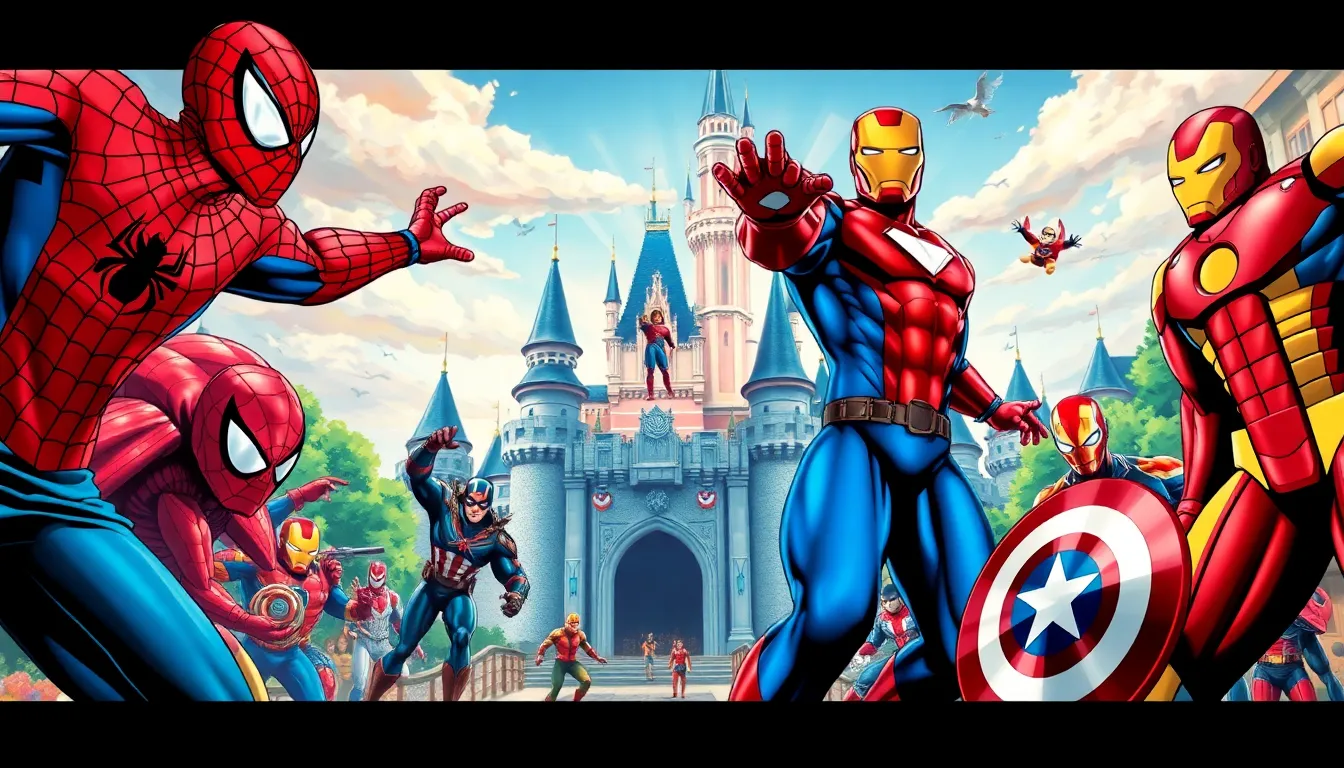Table of Contents
ToggleIn the world of entertainment, few acquisitions have had as profound an impact as Disney’s purchase of Marvel. This bold move not only reshaped the landscape of superhero films but also set the stage for a new era of storytelling. Fans around the globe were left buzzing with excitement, eager to see how Disney would breathe new life into beloved characters.
The acquisition took place in 2009 when Disney announced it had acquired Marvel Entertainment for a staggering $4 billion. This strategic decision marked a significant expansion of Disney’s portfolio, allowing it to tap into Marvel’s rich library of iconic superheroes and stories. As a result, the Marvel Cinematic Universe exploded in popularity, captivating audiences and redefining box office success.
Overview of Disney and Marvel
Disney, founded in 1923, represents a cornerstone of the global entertainment industry. It has created iconic animated films, theme parks, and television networks. Marvel Entertainment, established in 1939, became famous for its comic books and characters such as Spider-Man, Iron Man, and the Avengers.
The acquisition of Marvel by Disney in 2009 for $4 billion marked a pivotal moment for both companies. This acquisition enabled Disney to integrate Marvel’s extensive library into its media ecosystem. Marvel’s rich portfolio enhances Disney’s ability to create a variety of content across platforms, including films, television, and merchandise.
Following the acquisition, Disney capitalized on Marvel’s characters to launch the Marvel Cinematic Universe (MCU). The MCU has achieved unprecedented box office success, with films generating over $22 billion globally as of 2023. This success demonstrates how the acquisition allowed Disney to innovate and redefine superhero storytelling.
Disney’s robust marketing strategies and global distribution networks amplified the reach of Marvel’s franchise. The collaboration fostered the development of synergistic ventures, such as theme park attractions, merchandise lines, and animated programming. Such ventures solidified Marvel’s position within Disney’s diverse offerings, creating a win-win scenario for both brands.
Timeline of Acquisition

The timeline of Disney’s acquisition of Marvel outlines key events leading to the historic merger that reshaped the entertainment industry.
Pre-Acquisition Years
Before the acquisition, Marvel underwent significant transformations. In 1996, Marvel filed for bankruptcy, prompting a restructuring of its business model. Throughout the early 2000s, Marvel shifted its focus from comics to film, beginning with the release of “X-Men” in 2000, which set the stage for future superhero films, including “Spider-Man” in 2002. By the mid-2000s, Marvel established its own film studio, Marvel Studios, which produced the highly successful Iron Man in 2008, laying a strong foundation for its cinematic universe.
The Acquisition Year
In 2009, Disney announced its acquisition of Marvel Entertainment for $4 billion. This decision marked a pivotal moment in entertainment history. The announcement occurred on August 31, 2009, and completed on December 31 of the same year. The acquisition granted Disney access to Marvel’s extensive library of over 5,000 characters. It streamlined Marvel’s distribution channels, enhancing its ability to reach global audiences while expanding Disney’s portfolio to include superheroes. The merger fostered unprecedented growth in Marvel’s content production, leading to the launch of the Marvel Cinematic Universe, which revolutionized box office records.
Impact of the Acquisition
Disney’s acquisition of Marvel marked a turning point in the entertainment industry, enhancing content creation and distribution strategies for both companies.
Changes in Marvel’s Movie Releases
Marvel’s movie release strategy shifted significantly post-acquisition. Disney implemented a structured release schedule, leading to the introduction of multiple films annually, including blockbusters and franchise extensions. The MCU, with its coordinated storytelling across films, established a consistent release rhythm. This strategy ensured that audiences remained engaged year-round, ultimately contributing to record-breaking opening weekends and sustained box office success. For instance, the 2012 release of “The Avengers” grossed over $1.5 billion globally, setting a new benchmark. Disney’s marketing acumen further amplified these releases, creating multi-platform promotional campaigns that resonated with millions.
Expansion of the Marvel Universe
The acquisition facilitated an expansive growth of the Marvel Universe across various media. Characters and storylines from comic books transitioned seamlessly into films, television series, and theme parks. Notably, the Disney+ platform launched with original Marvel series, such as “WandaVision” and “Loki,” further building the franchise’s narrative cohesion. Merchandise offerings expanded significantly, with products ranging from action figures to apparel, strengthening brand visibility. This comprehensive integration solidified Marvel’s presence, turning it into a cultural phenomenon with a dedicated fanbase, generating billions in revenue and establishing a precedent for future cinematic universes.
Strategic Reasons Behind the Acquisition
Disney’s acquisition of Marvel in 2009 stemmed from multiple strategic reasons.
- Character Library: The acquisition provided Disney access to over 5,000 Marvel characters. This vast portfolio enabled the creation of diverse content across various media, enhancing storytelling opportunities.
- Brand Strength: Marvel’s established brand recognition and loyal fanbase complemented Disney’s own iconic characters. This synergy allowed Disney to tap into existing markets and expand its audience base significantly.
- Revenue Potential: Marvel’s comic book and film franchises generated considerable revenue before the acquisition. Disney recognized the potential for profitability in superhero films, which led to record-breaking box office successes, particularly with properties like “The Avengers.”
- Expanding Franchises: Integrating Marvel into Disney’s ecosystem facilitated the development of multiple franchises. The structured release schedule fostered a consistent flow of new content, driving audience engagement and bolstering ticket sales.
- Merchandising Opportunities: The merger enabled expansive merchandising prospects across various platforms. Disney’s expertise in marketing and global distribution enhanced Marvel’s merchandise offerings, creating lucrative sales avenues.
- Media Synergy: The acquisition created opportunities for synergistic ventures, including theme park attractions, television adaptations, and streaming services. Disney+ capitalized on this potential by featuring original series like “WandaVision.”
- Future Growth: Disney aimed for sustained growth in content production. The acquisition aligned with Disney’s focus on innovation and diversification in entertainment, positioning both companies for future success.
These strategic reasons played a pivotal role in shaping the subsequent integration of Marvel within Disney’s extensive entertainment framework.
Disney’s acquisition of Marvel in 2009 marked a transformative moment in entertainment history. By integrating Marvel’s iconic characters and stories into its expansive media ecosystem, Disney not only revitalized the superhero genre but also set new standards for box office success. The strategic partnership has led to innovative storytelling and a cohesive universe that resonates with audiences around the globe.
As both companies continue to grow and evolve, the impact of this acquisition remains evident in the ongoing success of the Marvel Cinematic Universe and the broader entertainment landscape. With a commitment to creativity and collaboration, Disney and Marvel are poised to shape the future of storytelling for years to come.








